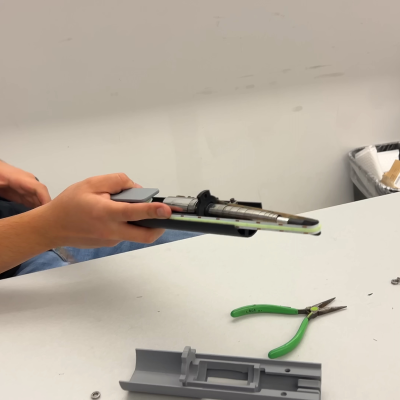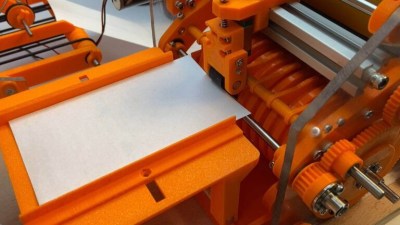Everyone has a lightsaber or two lying around the house, but not everyone has a lightsaber that extends and retracts automatically. And that’s because, in the real world, it’s not an easy design challenge. [HeroTech]’s solution for the mechanism is simple and relies on an old magician’s trick: the appearing cane. (Video, embedded below.)
 An appearing cane is a tightly coiled up spring steel sheet that springs, violently, to its full length when a pin is released, but they can’t retract while the audience is looking. This is fine for magic tricks, but a lightsaber has to be able to turn off again. Here, an LED strip does double duty as source of glow but also as the cable that extends and retracts the appearing cane spring. A motor and spool to wind up the LED strip takes care of the rest.
An appearing cane is a tightly coiled up spring steel sheet that springs, violently, to its full length when a pin is released, but they can’t retract while the audience is looking. This is fine for magic tricks, but a lightsaber has to be able to turn off again. Here, an LED strip does double duty as source of glow but also as the cable that extends and retracts the appearing cane spring. A motor and spool to wind up the LED strip takes care of the rest.
There are still a number of to-dos in this early stage prototype, and the one mentioned in the video is a tall order. Since the strip doesn’t illuminate out the sides, the lightsaber has two good viewing angles, and two bad ones. The plan is to rotate the LED strip quickly inside the sheath: an approach that was oddly enough used in the original movie prop, as demonstrated in this documentary. Doing this reliably in an already packed handle is going to be a challenge.
If you’re thinking you’ve seen a magic-cane lightsaber before, well, maybe you saw this video. And if you want a light saber with real lasers, check out this build that brings its own fog machine. Take that, Darth Vader!
Continue reading “Magic Cane Is The Secret Behind Lightsaber”



















